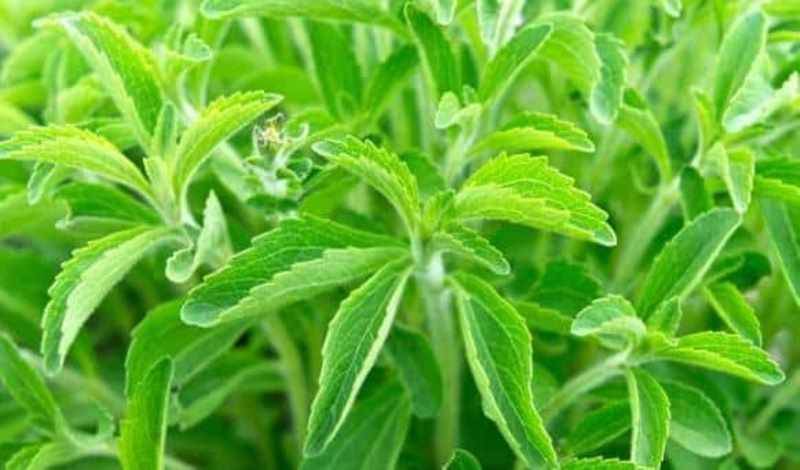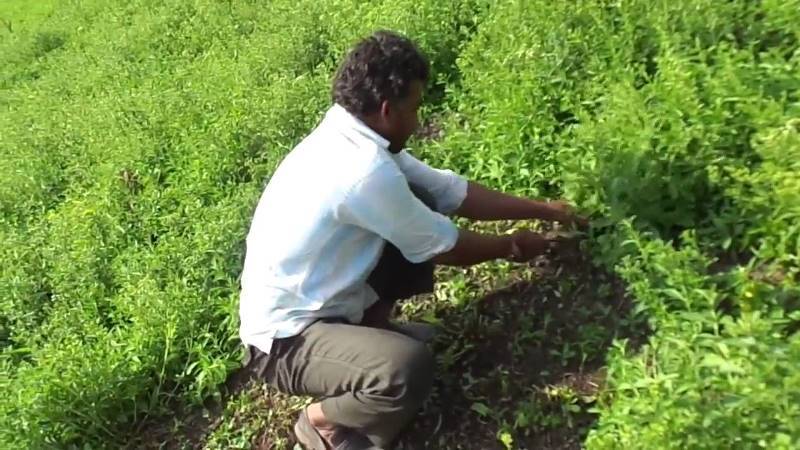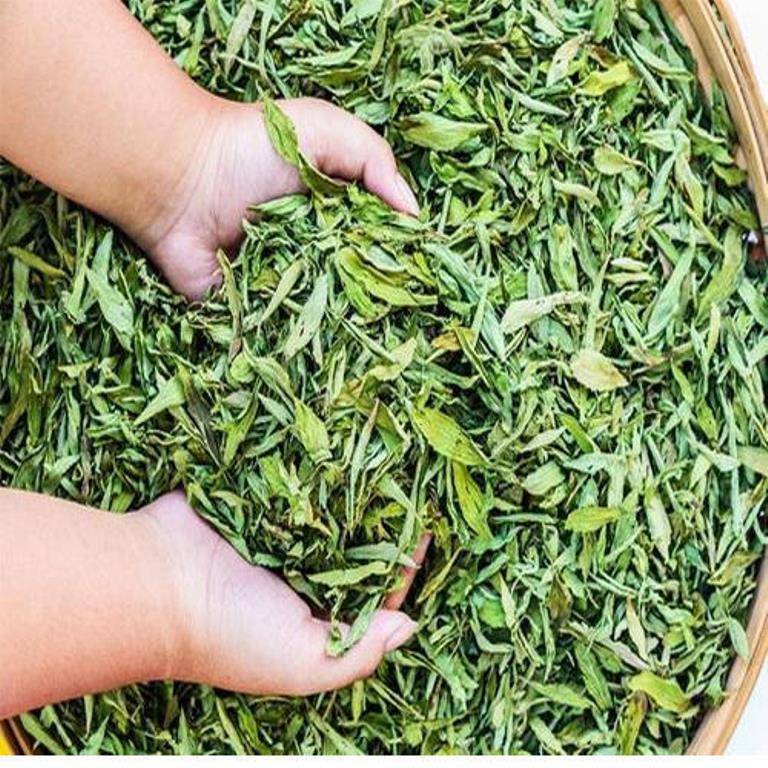
Stevia is a "wonder crop" with a strong sweet taste that has been used to sweeten drinks and make tea since the sixteenth century. During World War II, England started to examine stevia as a substitute for sugar, which was hard to find. But in the 1970s, the Japanese started to use stevia to replace the banned artificial sweetener, Saccharin. Currently, the stevia plant is grown in various nations around the world, such as India, China, Vietnam, Brazil, South America, South Korea, Taiwan, Israel, Argentina, Colombia, etc.
In 1971 Japan started to use stevia in its food. In 1984 China started its cultivation, in 1991 stevia was banned in the United States because of the early investigations that recommended the sweetener may cause cancer. However, in December 2008, the United States Food and Drug Administration(USFDA) acknowledged this contention, announced stevia GRAS and permitted its use in standard U.S. food production. In 2011 European Food Safety Authority approved the use of Steviol Glycosides as a sweetener and finally in 2015 FSSAI of India allowed the use of stevia in food items and beverages.
Stevia cultivation typically requires around 20 percent of the land and far less water to give a similar measure of sweetness as other standard sugars. Stevia farming gives a productive harvest to thousands of independent farmers having small lands. It does not replace food crops but is being cultivated as a cash crop on smaller plots in addition to food crops for an increase in revenue. When growing conditions are most favorable, farmers may harvest stevia several times per year.

Stevia Cultivation in India
Stevia is called by numerous names in various parts of India. Its most popular name is "Meethi Tulsi" and "Meethi Patti". In Hindi stevia is called 'Madhu Patrika". But in most of the places, it is generally known as "Meethi Tulsi" because of its uncanny similarity to the Tulsi plant in stature, leaf shape, and other physical qualities.
Stevia is also known as Sweetleaf, Honey leaf, and Sugar leaf. Though its farming is done throughout the world for a long time, it has been around two decades when the cultivation of stevia plant was introduced in India and currently it is growing up in a great way. Currently, India has about 30 million diabetic patients, which is expected to increase to 80 million until 2025. In this way, the Indian farmers have also started to take stevia cultivation to the next level trailing the huge demand for the diabetic market here. Presently India's total annual production of stevia is about 600 tons. The weather conditions in many parts of India are very good for stevia cultivation.
Stevia Growing States in India
Maharashtra, Punjab, Karnataka, Chhattisgarh, Madhya Pradesh, and Andhra Pradesh are major Stevia growing states in India. Gradually stevia farming is picking up in Uttar Pradesh as well.

Sowing Season of Stevia
Time for sowing is February to March of the year
Soil
Stevia plants love to grow in full sun. It is grown best in semi-humid locations with acidic, well-draining soil and environments especially in hot climates. It can be grown in a wide variety of soils but it gives the best outcome when planted in sandy soil to loamy soil with a well-draining system and high organic content. Stevia doesn't grow well in saline soils as it is harmful to its proper development. The pH ranging from 6.0 to 7.5 is best for the proper growth of the stevia plant.
Land Preparation for Plantation
Before planting stevia the farmer should have to plow his land at least 2-3 times to bring the soil to a fine tilth. In his first plowing, he should mix Trichoderma with the soil and at last plowing, FYM should be mixed well with the soil.
Spacing in Plantation
Transplantation of Stevia is done on raised beds. The raised beds ought to have 12 to 15 cm tall and 50 to 60 cm in width. Row-to-Row separation ought to be 40 to 45 cm and Plant-to-Plant separation ought to be around 30 cm. This count gives Stevia plant thickness as 20,000 to 25,000 plants for every one acre of land.
Plant Population
Plant density in Stevia Cultivation should be 25,000 to 30,000 per acre when seedlings are transplanted into the main fields.
Weed Control
Hand weeding is the most common way to expel weeds from the field. First, weeding is done following one month of planting, and afterward ensuing weeding is done at regular intervals.
Irrigation
Irrigation is the most significant part of stevia farming, water is irrigated to the plants through the sprinkler system or by drip irrigation technique. The plant doesn't require water in bounty so the light water system is given at proper interims. In summer, apply the water with an interval of 8 days. Don't overwater the plants and avoid stagnation of water in the field as it will harm the harvest.

Fertilizers and Compost
Stevia needs proper balanced nutrition for appropriate development and glycoside creation. Even though stevia was initially depicted as a yield with minimal outer nutritional support requirement, however, it was found later that it reacts well to fertilizer application. The nutritional management program for stevia relies upon soil and agro climate, cultivating framework, variety, and target yield.
During land preparation, apply FYM@200qtl/acre, cow dung/urine, and vermin compost and blend well in with soil. Apply fertilizer dose of N:P:K 11:45:45 kg/acre, Urea 24 kg, SSP 282 kg, and Potash 75kg/acre to land. Apply a full dose of SSP as a basal portion. Nitrogen and Potash are applied in 10 dosages each month. The splashing of Boron and Manganese is done to give the most extreme dry leaf yield.
Application of organic compost helps to keep roots cool, deter weeds, and also prevents moisture loss. Avoid using high nitrogen fertilizers, as they produce enormous leaves with little flavor. Give liquid organic fertilizers that are rich in phosphoric acid or potash content.
Species of Stevia
The family of Stevia has about 154 species; six species are generally used that are Stevia eupatoria, Stevia ovata, Stevia plummerae, Stevia salicifollia, Stevia serrata, and Stevia rebaundiana. From all these, Stevia rebaundiana is the one with noteworthy sweetening properties. The property of the species that pointed out the plant was the extraordinary sweet tests of the leaves and watery extracts.
Popular Varieties of Stevia with Their Yield
Below are some popular varieties of stevia which are grown in Indian Climate condition
MDS-13 and MDS-14: Both varieties gives the best result in Indian climatic conditions. It is suitable for cultivation in the regions with high temperatures and low rainfall.
SRB-123: This variety gives the best result when grown in the Deccan plateau where it can be harvested 3-4 times in one year. Its total Glucoside content varies between 9-12 percent
SRB-128: This variety is suitable for both southern as well as north Indian climates. It has a very high total glucoside content of 14-15 %.
SRB-512: This variety grows well in northern latitudes and it can be harvested 3 or 4 times in one year. Total glucoside content varies between 9-12 %.
Pests Control in Stevia
Most pests are not found in Stevia crops because steviol glycoside itself has a sizeable pest repellant quality, but some of the modern high yielding breeds of Stevia needs crop safety to some extent. However, if pest appears they can be controlled by spraying neem oil with diluted water on the crop.
Commonly, non-favorable conditions, the excessive moisture level in soil and air, weed infestation, and unbalanced nutrients becomes the reason for pests and diseases in stevia crop. At this moment, perfect nutrients and appropriate agronomic management can work as a shield.
Diseases of Stevia
Septoria stevia:
Grey spot appear on leaves followed by chlorosis is caused by the fungus Septoria steviae. The disease spreads most fastly during high rainfall with cool night temperatures. It causes leaf lesions and serious yield losses to stevia. Fungicides are used to manage Septoria leaf spot in stevia plants leaves. It can also be controlled by giving a controlled water supply to the plants. Leaf Spots can also be controlled by spraying borax 6 percent to the plants.
Sclerotinia sclerotiorum:
Symptoms include wilting stems that are bleached at the base. As symptoms progress, stems and leaves get necrotic. Once a stem is infected, brown spots appear on the stem, and symptoms progress results as the death of the stem and finally, the whole plant collapses.
There are basically three methods for controlling Sclerotinia sclerotiorum; chemical, cultural, and organic control. The chemical and cultural control technique is generally used to lessen infection. The main synthetic control that is utilized to control Sclerotinia sclerotiorum is fumigation.
Southern blight:
it is caused by soil-borne fungus Sclerotium rolfsii. Soil solarization is an effective way to kill Southern blight.
Harvesting and Storage
The first harvest of the crop can be done in four months after planting and ensuing harvest once every three months. Generally, after 40 to 60 days of harvest, you can go for the next one.
Green stevia should be harvested early in the morning when it has the highest sugar content. Cool temperatures and short days heighten the sweetness of stevia. From one plantation cycle, a farmer can produce three harvests. Each harvest cycle should be performed with a space of 3-4 months.
For drying the leaves, tie the stems in small bundles and hang them upside down in a cool, dark and well-ventilated room until the leaves dry. When green leaves turn dry, remove the leaves from the stems and store in airtight containers. Grind them into a powder before use.
Packaging
Dry leaves are stored in plastic-lined cardboard boxes and then sealed, tied, and labeled for additional processing. After being powdered it is packed and leveled appropriately for sale.
Marketing
The powder of stevia as holds the biggest market share overall, trailed by fluid and leaf. On the basis of its use, stevia is mainly used in the food, beverages, and pharmaceutical markets. Its demand in the beverage division is comparatively high because of the rising demand for low-calorie drinks.
Stevia extract is currently imported generally at the cost of Rs 5.5-6.5 lakh for 100 kg shipment. Local produce would be a major assistance. A gauge puts the stevia items market to develop about '500 crores by 2022. In order to support farmers, the National Medicinal Plants Board (NMPB) has declared a 20% subsidy at the expense of production stevia.
Training Centers of Stevia Cultivation
In order to endorse Stevia farming in India, there are some institutes and research centers that offer Training of Stevia Cultivation to the farmers. Below are some listed institutes;
Bhagya Shree Herbal Farms, Raipur, Chhattisgarh offers training, assistance, and consulting services for Stevia Cultivation.
National Medicinal Plant Board, Ministry of Ayush, Government of India also offers training and awareness programs for the development of medicinal plant cultivation.

Stevia and Medicinal Plant's Cultivation Training by HCMS
Hahnemann Charitable Mission Society(HCMS) organizes stevia cultivation training programs for farmers at Pink City Jaipur. In this program, farmers are intensively trained on cultivation, harvesting, and marketing techniques of medicinal crop stevia. They also get practical training by experienced experts in stevia farming. The duration of this training is for two days and the place of training in Jaipur.
Sunrise Institute and training Center
This institute is situated in Rajasthan and offers training for Stevia cultivation. Along with several training programs such as Medicinal Plantation, Dairy Development, Nursery Management Training Program, Waste Land Management, the institute has also designed the Stevia Cultivation training program to give more information to the farmers about organic farming. Its a short term course.
Medicinal Herbals Cultivation Training Program by Amritanjali an SSP Group of Company
Located in Rajasthan, Amritanjali offers two Days Comprehensive Training program which provides technical and practical knowledge about the Plantation, Cultivation, Harvesting, and Processing of Stevia, Aloe Vera and Other Medicinal Herbs. During this period the institute aware farmers to the theoretical and technical details about subsidies and loans provided by Government Bodies for the cultivation of medical herbs such as Stevia, Aloe Vera, Lemon Grass, Satavar, Tulsi, Neem, etc.
Loans and Subsidies for Stevia Cultivation
-
Organic Innovation, Assam is an organization that gives material for Stevia farming on 100 percent cashback agreement and provide training to the farmers on stevia cultivation free of cost.
-
Hahnemann Charitable Mission Society(HCMS) offers financial and material support to the farmers for Stevia farming. HCMS is an NGO located in Pink City Jaipur.
-
One of the govt. association NABARD is also offering loans and subsidies for Stevia Cultivation. NABARD loans and subsidies are based on project reports of the farmer.
-
AYUSH and The National Medical Plant Board jointly offer a subsidy of 30 percent, a maximum of Rs 30 lakhs, on the total cost of Stevia Cultivation.
Medicinal Properties and Health Benefits of Stevia Plant
Stevia is known for its medicinal properties. Extracts from stevia leaves have been used for quite a long time as a medicinal herb in the conventional treatment of diabetes. When contrasted with sugar, stevia consumption before meals results in far lower after-feast glucose and insulin levels.
Stevia leaves contain more than eight different steviol glycosides that are Stevioside, Rebaudioside A, C, D, E, and F, Steviolbioside, Dulcoside A. It has antioxidant, antimicrobial, anti-inflammatory, anti-tumor, antifungal, anti-diarrheal, immunomodulatory, antimicrobial, anti-hypertensive, and hypoglycemic properties. Below are the health benefits of Stevia;
⦁ Stevia may help to control high blood pressure
⦁ Stevia may help to control blood sugar and insulin levels
⦁ Stevia may help in weight loss
⦁ Stevia may help in healing the wounds faster
⦁ Stevia may fight acne, pimples, and dandruff
⦁ Stevia may help to protect teeth and gums from cavities
⦁ Stevia may reduce heartburn and indigestion
⦁ Stevia may help to reduce fine lines and wrinkles
Stevia Seeds Manufactures and Sellers in India
Vanashree Agrotech
This company sells Stevia Seeds for cultivation that can yield good quality stevia plants. They offer seeds at Rs 5,000 per Kilogram.
Along with seeds Vanashree Agrotech also provides Stevia Plants at Rs 1.2 per Unit. Minimum Order Quantity is 40000 Units.
They offer their customers high-quality organic Stevia seeds as well as stevia plants for Plantation as well as provide complete assistance too.
Address: J-116, Megacentre, Magarpatta, Hadapsar, Pune, Maharashtra 411028
Maati Tatva Agro Industries
This company sells Stevia Seeds at Rs 500 per Kg.
Address: 7/1, Kumavat Pura, Juni Indore, Indore, Madhya Pradesh 452007
Phone: 099267 37767
Mediaroma Agro Producer Company Limited
This company is one of the leading Manufacturer of Stevia Plant from Kasganj, India. They sell a Stevia plant at Rs 0.70 per piece.
Minimum Order Quantity is 5000 Pieces
Address: 1328, Chitragupta Colony, Kasganj- 207123, Uttar Pradesh, India.
Green Era Foods & Nutraceutics
This Company offers stevia seeds at Rs 2,000 per Kilogram.
Address: Plot No- 2166, B-2/B, Gurudarshan Tenament, Behind Ashish Jyot Flats, Sanskar Mandal Rd, opp. Hotel Sankalp, Bhavnagar, Gujarat 364002
Phone: 080 6809 2054
Al Habib Herbs & Seeds
This company sells stevia seeds at Rs 2,500 per Kg
Address: Pragati Vihar, Near Defence Colony, Behat Road, Saharanpur- 247001, Uttar Pradesh, India
Honey leaf, Stevia is a non-caloric natural source option in contrast to artificially produced sugar substitutes. It is used as a sweetener, medication, beauty products, bread, juices, confections, yogurt, and a lot progressively eatable and pharmaceutical items.
The enlarging awareness about the medical advantages of stevia over sugar has prompted a worldwide increment in its demand due to which it is currently grown commercially across the world. Most of the low-calorie sweeteners available in the market are artificial, so the interest of natural sweeteners like stevia is expanding globally. Many other elements impacting the worldwide demand of stevia are the changing lifestyles, mindfulness to be healthy, expendable salaries, government initiatives on lessening the sugar consumption, and the need to battle medical issues like obesity and diabetes.
Stevia is used as a healthy option to added sugar in various food items and drinks. Even though stevia is 200 to 300 times sweeter than standard sugar, so less quantity can be utilized to sweeten refreshments and food.
By picking the natural sweetness and pleasantness of stevia, customers can help individuals with keeping up a stimulating and nature-friendly eating regimen and that is something that buyers, health experts, and food makers would like.















